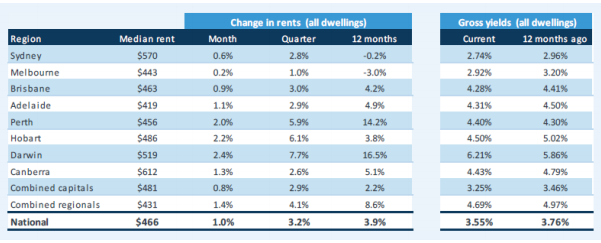Top yields revealed: Rents grow at fastest pace since 2007
Housing rents are rising at the fastest pace since 2007, but experts are warning that rental conditions around the country are extremely diverse.

National rental rates have surged 3.2 per cent in the March quarter, representing the largest quarterly increase since May 2007, with the regions, Darwin and Perth driving much of the growth, CoreLogic’s new quarterly rental review revealed.
Unsurprisingly, the combined regional markets saw a stronger lift in rents than the capital cities, recording growth of 4.1 per cent in the first quarter compared with a combined increase of 2.9 per cent in the cities.
But what is surprising is that regional units recorded the highest quarterly rental growth of 4.8 per cent compared with a 4.0 per cent hike in house rents, despite a growing preference for larger spaces. In the cities the figures were on par with trends, with unit rents up 2.0 per cent compared with houses, which gained 3.3 per cent in the three months to March.
But while housing rents are rising at the fastest pace since 2007, the headline reading hides the sheer diversity of rental conditions around the country, CoreLogic research director Tim Lawless cautioned.
“At one end of the spectrum, we have Perth and Darwin where annual rental growth is well into double digits and accelerating. At the other end is Melbourne and Sydney where rents are down over the year,” Mr Lawless said.
In fact, houses and units in Darwin showed the strongest growth in rental rates over the quarter, up 8.2 per cent and 7.0 per cent, respectively. In Perth, quarterly growth stood at 5.9 per cent for houses and 6.0 per cent for units.
In Australia’s two largest cities, Sydney and Melbourne, growth stalled as closed international borders exasperated a demand shock already challenged by high supply.
Melbourne unit rents dropped 8.2 per cent over the year, while Sydney unit rents contracted 4.9 per cent.
“Some inner-city precincts of Melbourne have seen unit rents fall by more than 20 per cent over the past 12 months,” Mr Lawless said.
The expert noted that prospects for a material improvement in rental conditions across these inner-city high-density precincts are largely dependent on a return of tenancy demand from international students and visitors.
Canberra, on the other hand, was not only the most expensive market to rent a house across the capital cities, but also the most expensive capital city unit rental market in the quarter at $513 per week.
But Mr Lawless pointed to another discrepancy, noting that although rents are generally rising, housing values have been rising at a faster rate, which has seen rental yields compress across most of the capital cities.
“The exceptions are Perth and Darwin where rents have risen at a faster pace than housing values, driving a rise in yields. The opposite is true in Sydney and Melbourne where rental yields are plumbing new record lows.
“Outside of Sydney and Melbourne, with mortgage rates so low, yields are generally high enough to provide investors with positive cash flow opportunities from the outset,” Mr Lawless concluded.

